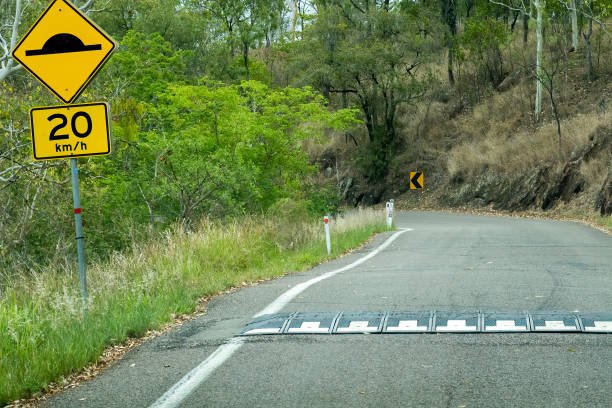Speed bumps offer the primary function of slowing down traffic and fast-moving vehicles to prevent collisions and harm to persons and property. There are warning signs on the route asking motorists to reduce their speed. These are often installed on city streets rather than highways since sudden stops may also result in accidents. Drivers adhere to traffic regulations, are well-aware of the various types of speed bumps, and do not exceed the posted speed limits.
Every road and vehicle, however, has a finite capacity, and turning and twisting around routes calls for a lower speed for safer bends, which may be hazardous. The advantages and disadvantages of speed bumps nowadays may have an impact on individuals as they travel various routes.
Exploring the advantages of speed bumps
The purpose of the bumps is to make walking and driving alike safe. Although most drivers find them bothersome, this helps to a greater degree to regulate the traffic situation. Speed bumps provide several benefits in highly populated regions if there are schools and hospitals nearby.
Useful in residential and school zones
These areas are busy due to the large number of youngsters living there as well as the marketplaces and neighborhood stores that serve residents. For the protection of the local populace and kids, no high-speed motor vehicles may be permitted to operate freely in certain locations. In highly crowded locations, speed bumps are used to restrain other cars and riders while still allowing them to go at a safe pace.
It is easy to construct a speed bump
Bump building is fairly simple and doesn’t need for a lot of expensive equipment. With same material that is used for roadways, they may be easily made and erected wherever they are required. They may be built concurrently with the construction of roads since it is a component of road construction. Depending on the kind of road and the climate, speed bumps may be constructed from any material, including rubber, plastic, and concrete.
They help with traffic management
The fact that speed bumps may be quite beneficial in managing and regulating traffic is another practical use. The traffic flows routinely, while the occasional obstruction makes it go more slowly and prevents major traffic issues.
They help to reduce accidents
Safetyfirst have noted to our reporter that the WHO estimates that 1.3 million people die in traffic accidents and collisions every year. Speed bumps are indeed a good strategy to keep over speeding under control since it is the primary cause of these collisions. It might not be able to end all of these conflicts, but it can at least lessen them somewhat. A study from the UK found that speed bumps aid to cut down on traffic accidents by 44%.
They limit excessive speeds
A speed bump’s principal objective is to slow down fast-moving vehicles by blocking their path. They can only regulate them up to a point, after which vehicles must use caution around young children and pedestrians in residential areas.
Exploring the disadvantages of speed bumps
These buildings often have a high crown, making passing them at faster speeds unsteady for both the car and its occupants. They may also be an issue for pregnant women, bike riders, and ambulances in addition to being very irritating. Finally, inclement weather, such as snow or rain may exacerbate the negative effects of speed bumps by making the road slicker.
Sound of traffic
Since cars must restart their engines after passing over a speed bump, they are the source of the majority of traffic sounds. When the pace drops to 10-15 miles per hour, drivers rush to crank the engine to its maximum speed. Over your head, this results in loud traffic sounds and horn blaring. Residents and those around may sometimes find this to be quite bothersome.
Reroutes traffic
In order to avoid more bumpy roads, drivers often choose an alternative route. Another route experiences more traffic as a result and begins seeing regular traffic. Local motorists become familiar with the road & avoid getting stuck on routes with rough rides.
Need Reaction Time
For a safe journey, the car must slow down gradually; otherwise, the braking system as well as tires may be overworked. These may potentially result in braking failures and skidding of the brakes. Unfortunately, it also contributes to a lot of accidents.
When the road is blanketed with snow, the drawbacks of speed bumps might be more obvious. Drivers run the danger of being in an accident if there is no warning or painted guidance.
They cause damages to vehicles
The harm that a speed put in the improper location might do to drivers and cyclists is far greater. Similar to how poor sight might easily cause you to miss a speed bump that poses dangers. Speed bumps placed at steep turns may be challenging for cyclists as well. To prevent losing equilibrium at high speeds, the majority of sports cars feature chassis constructions that are somewhat lower. Humps may therefore collide with the vehicle, damaging the lowest portions of the vehicles and motorcycles.
They slow down emergency vehicles as well
Along with other vehicles, emergency vehicles such as ambulances, fire engines, police cars, water trucks, and food trucks experience delays. For cars to arrive at their destinations on time, speed is essential. In addition, the raised buildings on the roadways cause the sufferers to experience jerks.
Final words
Since road bumps may be both an issue and a remedy from various angles, it might be difficult to determine their value. If you spend hours behind the wheel, the benefits and drawbacks of speed bumps are extensive. Locals benefit from speed bumps, but they are problematic for passengers and drivers. These structures maintain stable speeds when positioned at regular intervals, however they might cause problems if misplaced. You should evaluate these pros and cons to determine whether you should be getting speed bumps or not.
















